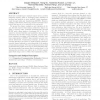Free Online Productivity Tools
i2Speak
i2Symbol
i2OCR
iTex2Img
iWeb2Print
iWeb2Shot
i2Type
iPdf2Split
iPdf2Merge
i2Bopomofo
i2Arabic
i2Style
i2Image
i2PDF
iLatex2Rtf
Sci2ools
100
Voted
MOBICOM
2012
ACM
2012
ACM
Argos: practical many-antenna base stations
Multi-user multiple-input multiple-output theory predicts manyfold capacity gains by leveraging many antennas on wireless base stations to serve multiple clients simultaneously through multi-user beamforming (MUBF). However, realizing a base station with a large number antennas is nontrivial, and has yet to be achieved in the real-world. We present the design, realization, and evaluation of Argos, the first reported base station architecture that is capable of serving many terminals simultaneously through MUBF with a large number of antennas (M 10). Designed for extreme flexibility and scalability, Argos exploits hierarchical and modular design principles, properly partitions baseband processing, and holistically considers realtime requirements of MUBF. Argos employs a novel, completely distributed, beamforming technique, as well as an internal calibration procedure to enable implicit beamforming with channel estimation cost independent of the number of base station antennas. We rep...
Base Station Antennas | Communications | Computer Communication Networks | Internal Calibration | MOBICOM 2012 |
| Added | 27 Sep 2012 |
| Updated | 27 Sep 2012 |
| Type | Journal |
| Year | 2012 |
| Where | MOBICOM |
| Authors | Clayton Shepard, Hang Yu, Narendra Anand, Erran Li, Thomas L. Marzetta, Richard Yang, Lin Zhong |
Comments (0)

